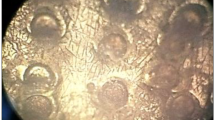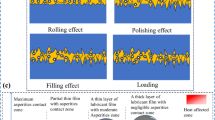Abstract
In this paper, the possibility of the transfer of additives that are in the emulsion mist is shown by the example of the bronze CuSn7Zn4Pb6–stainless steel X10CrNi18-8 friction pair. The additive is first transferred on the processed surface of the part and through it–in the contact zone of the friction pair. It was established that the emulsion mist reduces the roughness of machined stainless steel surface more than three times, and the introduction of additives based on phosphate esters into the emulsion reduces the roughness by 4–4.5 times. Phosphate-based additive remains on the machined surface in significant quantities, even after 30 min working at heavy loads, reducing the instantaneous friction coefficient and the temperature of the friction zone. The mean width of profile elements of the assessed profile of bronze samples decreases by two times and their bearing length ratio decreases by four times. In this case, a decrease in the wear rate of bronze by more than 40% is ensured. This fact indicates the better running-in of the friction pair.
Similar content being viewed by others
References
GOST (State Standards) 30858–2003: Tribotechnical Requirements and Indices. Principles of Security. General Regulations, 2003.
Tushinskii, L.I. and Poteryaev, Yu.P., Problemy materialovedeniya v tribologii (Problems of Material Science in Tribology), Novosibirsk: Novosib. Elektrotekhn. Inst., 1996.
Kuksenova, L.I., Gerasimov, S.A., and Lapteva, V.G., Iznosostoikost’ konstruktsionnykh materialov (WearResistance of Construction Materials), Moscow: Mos. Gos. Tekhn. Univ., 2011.
Suslov, A.G., Bez”yazychnyi, V.F., Panfilov, Yu.V., Bishutin, S.G., Govorov, I.V., Gorlenko, A.O., Gorlenko, O.A., Petreshin, D.I., Sakalo, V.I., S’yanov, S.Yu., Tikhomirov, V.P., Fedonin, O.N., Fedorov, V.P., Finatov, D.N., and Shcherbakov, A.N., Inzheneriya poverkhnosti detalei (Engineering of Detail Surface), Suslov, A.G., Ed., Moscow: Mashinostroenie, 2008.
Pugacheva, N.B., Pavlyshko, S.V., Trushina, E.B., and Zamyatin, A.N., Investigation of mass transfer during tribological interaction of alloyed steels, J. Frict. Wear, 2012, vol. 33, pp. 208–216.
Belyi, A.V., Ganavati, B., Kukareko, V.A., Bekish, Yu.N., and Tsybul’skaya, L.S., Structure and tribological properties of the electrodeposited Fe–Ni coating treated with nitrogen ions, J. Frict. Wear, 2014, vol. 35, pp. 177–180.
Sachek, B.Ya., Mezrin, A.M., and Zaitsev, A.N., Experimental study of the speed-dependence tribotecnical characteristics of some plasma-sprayed oxide coatings at elevated temperatures, J. Frict. Wear, 2014, vol. 35, pp. 194–200.
Basinyuk, V.L., Levantsevich, M.A., Maksimchenko, N.N., and Mardosevich, E.I., Improvement of triboengineering properties and noise reduction of tooth gears by cladding functional coatings on working surfaces of interfaced teeth, J. Frict. Wear, 2013, vol. 34, pp. 438–443.
Sviridenok, A.I., Kravtsevich, A.V., Lysenko, V.I., Mikulich, S.I., Ignatovskii, M.I., and Bardakhanov, S.P., Tribological properties of thin coatings based on epilams modified by nanosized silica, J. Frict. Wear, 2014, vol. 35, pp. 161–169.
Buyanovskii, I.A., Boundary lubrication by an adsorption layer, J. Frict. Wear, 2010, vol. 31, pp. 33–47.
Feldshtein, E. and Maruda, R., The influence of emulsion mist modifiers on surface roughness of steel C45 and the state of rake face of cutting edge after turning, Tribologia: Teoria i Praktyka, 2007, no. 2, pp. 175–185.
Feldshtein, E. and Maruda, R., Some regularities of the heat transfer in the process of cooling of a cutting zone by an emulsion fog, J. Eng. Phys. Thermophys., 2006, no. 3, pp. 606–610.
Author information
Authors and Affiliations
Corresponding author
Additional information
Original Russian Text © R.W. Maruda, E.E. Feldshtein, S. Legutko, G.M. Królczyk, 2015, published in Trenie i Iznos, 2015, Vol. 36, No. 6, pp. 706–713.
About this article
Cite this article
Maruda, R.W., Feldshtein, E.E., Legutko, S. et al. Improving the efficiency of running-in for a bronze–stainless steel friction pair. J. Frict. Wear 36, 548–553 (2015). https://doi.org/10.3103/S1068366615060082
Received:
Published:
Issue Date:
DOI: https://doi.org/10.3103/S1068366615060082




